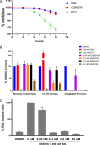Antiviral Properties of HIV-1 Capsid Inhibitor GSK878
- PMID: 37039636
- PMCID: PMC10190262
- DOI: 10.1128/aac.01694-22
Antiviral Properties of HIV-1 Capsid Inhibitor GSK878
Abstract
GSK878 is a newly described HIV-1 inhibitor that binds to the mature capsid (CA) hexamer in a pocket originally identified as the binding site of the well-studied CA inhibitor PF-74. Here, we show that GSK878 is highly potent, inhibiting an HIV-1 reporter virus in MT-2 cells with a mean 50% effective concentration (EC50) of 39 pM and inhibiting a panel of 48 chimeric viruses containing diverse CA sequences with a mean EC50 of 94 pM. CA mutations associated with reduced susceptibility to other inhibitors that bind to PF-74 binding site (L56I, M66I, Q67H, N74D, T107N, and Q67H/N74D) also reduced susceptibility to GSK878, with M66I, Q67H/N74D, and L56I having the greatest impact on antiviral activity. Amino acid substitutions in the CA cyclophilin A (CypA) binding loop (H87P and P90A), distal from the inhibitor binding site and associated with reduced CA-CypA binding, subtly, but reproducibly, also decreased GSK878 potency. Mechanism-of-action studies showed that GSK878 blocked both early (preintegration) and late (postintegration) steps in HIV-1 replication, with the early inhibition primarily determining the compound's antiviral activity. The early inhibition results from blocks to HIV-1 nuclear import and proviral integration and is associated with altered stability of the HIV-1 CA core.
Keywords: antiviral activity; capsid core stability; capsid inhibitor.
Conflict of interest statement
The authors declare a conflict of interest. At the time of this study, all authors were employees of ViiV Healthcare and C.W., K.P., M.I.C., J.F.K., E.P.G., M.K., and R.A.F. are shareholders in GSK.
Figures




References
MeSH terms
Substances
LinkOut - more resources
Full Text Sources

